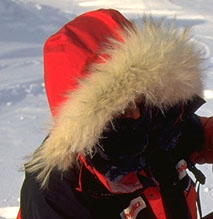|
|
|
The furs
All parts of the body can be protected against the cold by insulating
garments; but, as far as the face is concerned, you obviously
need to be able to breathe and be able, despite the cagoule or
mountain cover, to have sufficient vision to make progress and
see all around. Air which we breathe when temperatures are low
is very dry, but exhaled air contains a large amount of water
vapour produced by our metabolism. When it is very cold and progress
is essential, maximum protection is needed. Even neoprene face
masks just as storm glasses are not ideal. In fact, exhaled water
vapour crystalizes directly (transition from vaporous state to
a solid state) and forms a layer of ice which quickly becomes
a shell of ice which, instead of protecting, can lead to localised
frostbite. In these extreme conditions, only a fur can make life
bearable. The multitude of hairs creates a beneficial microclimate
which considerably moderates the unpleasant effects of the wind-chill
factor. Exhaled water vapour condenses on the hairs and emits
a sizeable quantity of heat (about 700 calories per gram); when
the fur is covered in icicles, a knock with the mittens is enough
to make all the ice fall off . .
|

